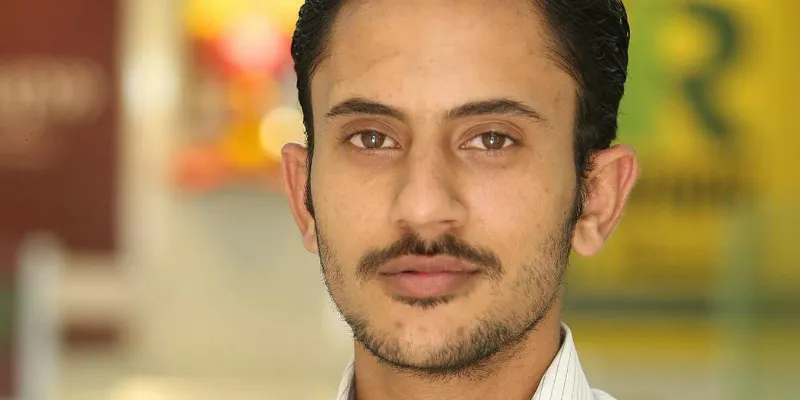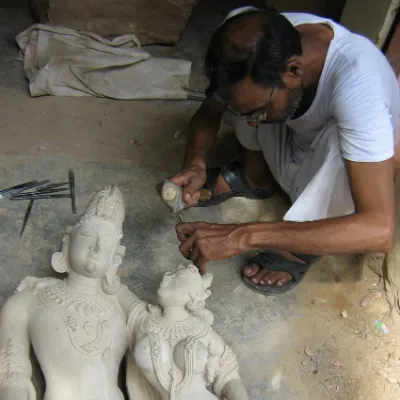This entrepreneur from Mathura is saving sculptors and painters from exploitation through its online art platform
Samarth Chaturvedi's Maitreya Inc onboards artists onto its digital platform for free and sells their artwork at just two percent commission on sales. It has a collection of over 700 antique pieces and 2,000 artworks.
For decades, Indian sculptors and painters have faced many challenges in monetizing their skills. Agencies and art dealers which help sell artwork have been exploiting independent sculptors and painters by asking for high upfront fees and commissions. Many times, these middlemen resell newly-made art as antique products to misinformed customers and keep the money to themselves.
But when YourStory’s Brands of India 2019 award winner Samarth Chaturvedi (28) was growing up in Mathura, he saw something else. He used to see his father working alongside sculptors and painters, but he did not see the kind of exploitation seen in other places. Instead, Samarth’s family business used to make stone, bronze and terracotta sculptures and directly sell them to museums and private collectors. This kind of model eliminated the need for middlemen and safeguarded the interests of the artists.

Samarth Chaturvedi, Founder, Maitreya Inc
So when the business was forced to shut due to heavy losses, Samarth decided to quit his cushy marketing job to revive his family business. “I still remember my father facing frustration, sickness and depression due to non-payment from major buyers and closing the business. But I thought I could revive it by using my skills in economics, business development, research, digital marketing, and art,” he says.
In 2010, he started Maitreya Inc by bringing 145 painters and 70 sculptors from across India together. His vision was to build a platform to bring their talent to the front and sell to a wide range of customers. Along with his father, Birendra Nath Chaturvedi, Samarth put together a collection of over 700 antique pieces and more than 2,000 other artworks.
The father-son duo did all of this without external funding. Samarth says that they have not raised funding because the industry is not developed enough to attract large investments. But he adds that international businesses are now approaching Samarth to collaborate and tap into the large network of artists curated by Maitreya.
Business model
“We brought all of the artists on our online platform for free. We took help of the government to reach out to more artists,” he explains.
On the website, the artwork is exposed to a wide range of potential buyers and collectors who can pick out and buy them.
Under the new gen entrepreneur, Maitreya quickly became a consistent manufacturer of top-quality bronze and stone sculptures, miniatures, and paintings. Samarth says that many of these artworks are now part of major private and public art collections. Maitreya now employs 35 people and has recently bagged Rs 5 crore order from China and Thailand for Buddha sculptures.
Samarth says, “At one point of time we were recording a Rs 36 crore turnover per year, but we had to suddenly close. Now, after revival, we are slowly rebuilding and have a turnover of Rs 1.4 crore.”

A Maitreya artist working on a sculpture
He is constantly trying to bring more artists under his wing so they don’t have to face unfair trading practices. “Coming from an artist family, I knew I wanted to reduce the impact of art dealers taking advantage of sculptors and painters,” he says.
Samarth explains how profit sharing is skewed towards dealers. According to him, a lot of dealers ask for Rs 2,000 to Rs 10,000 per painting just to display it. If the painting is sold, only 70 percent of the money is given to the artist. The agency or dealer keeps the rest.
Some dealers allow artists to display their work for free, but take 60 percent of the amount it is sold for. Samarth adds that if enough artwork is not sold, the dealer forcibly takes a few paintings or sculptures for free as ‘display charges’.
Others buy high quality art for cheap and resell them to foreign markets by branding them as antiques. Many such sculptures and paintings have become part of great museums in Europe and in the US, Samarth says.
“This is a business-focused approach from the dealers and made the artists helpless,” he says. “These independent artists don’t have the resources or network to find or generate their own markets. They are not powerful enough to stand against the policies of large art dealers.”
Maitreya’s online platform works very differently. It onboards artists and their products on to a website free of cost, and charges them just two percent of the selling price. “98 percent is given back to artists so they have enough money to keep making great art and preserve our culture,” Samarth says.
It also leverages social media platforms such as Instagram, Facebook and LinkedIn to connect with buyers. “Digital mediums have helped us understand the market and how our competitors work. Because of this, many competitors are now our partners under the common goal to boost the value of art,” he adds.
Creating an impact
With this model, Maitreya has been instrumental in developing major museum collections in the Metropolitan Museum of Art in New York, the Delhi National Museum, Mathura Museum, and distinguished private collections worldwide, according to Samarth. It has also worked on art projects for ITC Group, Ballarpur paper mill industry, Khaitan, and other Indian collectors.

A painting on Maitreya Inc's platform
Samarth says Maitreya also aims to preserve art which is at the risk of getting forgotten or lost over time.
He says, “Art connects things like history, culture and religion together. But sadly, is not given much importance or is exploited. So we stopped working with dealers who didn’t treat art with respect or who tried to exploit artists.”
Maitreya has also set up an education centre to teach about science and arts. It wants to recreate the Mathura School of Arts - a long-lost art institute. Simultaneously, the company wants to find ways to preserve heritage and archaeological sites from destruction.
“We also want to restore a lot of artwork which has been demolished or spoiled due to negligence. We will keep on this mission and provide quality sculptures and paintings to the right buyers,” he says. “We will surely go ahead with raising investment to take the business to a larger scale.”


1553161965957.png?mode=crop&crop=faces&ar=2%3A1&format=auto&w=1920&q=75)




